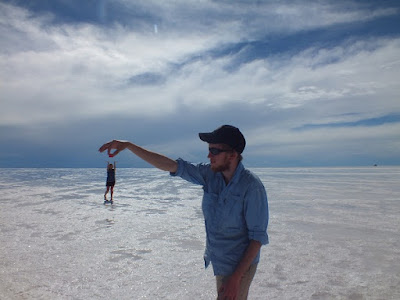Fellow adventurers,
Apologies for the lack of updates. We've spent the majority of the past week in a desert, without any internet.
An additional day was added to our time in Potosi, due to food poisoning. Luckily, we recovered in enough time to make the 6 hour bus ride to Uyuni to arrange for a 3 day tour of the salt flats and other geologic formations before crossing the border into Chile. We snacked on saltines and bananas at an attempt to gain back our strength and appetites. The ride to Uyuni had some close calls, as the bus needed to stop or dodge packs of llamas crossing the street. As we neared Uyuni, communities became more scarce, the landscape more dry, and the road went from paved to dirt as we continued to rise in elevation.
While in Potosi, we had researched potential tour companies out of Uyuni, hoping to go with a reputable company. After reading many reviews regarding drunk and/or negligent tour drivers in vehicles that had come under disrepair, we realized that choosing a company would be like how many things have been in Bolivia; a 'crap shoot.' We selected a few companies that had some better reviews than others, and set out early in the morning to find one and hopefully book a tour to depart later in the day. After some detailed information of the tour, asking questions, and a bit of price negotiation, we decided on a tour with an English speaking guide.
The land cruiser arrived. We met another couple from Australia whom we would be sharing the tour with, Ray and Rebecca. Our driver took our bags and along with a few gallons of gasoline, and secured them to the roof. We picked up two other travelers from Columbia, Julian and Diego on the way to our first stop, a 100+ year old train cemetery outside Uyuni. Our guide, Israel, explained the reason why the trains were abandoned in the 1940s. It was due to a mining industry collapse, and partly due to mineral depletion.
Afterwords, we headed to what would be the highlight of the journey, the worlds largest salt flats, also know as the Salar de Uyuni. We had been told that due to the flooding rains expected of the wet season, we would only be visiting the flats as opposed to driving through them. An oasis of sorts awaited us in the distance, as the mountains reflected off the clear shallow waters that lay upon the white salt. The land cruiser navigated through the water, towards the center of the flats where a museum stood, constructed entirely of salt bricks.
Our shoes came off before we stepped out of the vehicle. The water was warm, and the ground rather rough. Often times, we needed to watch our footing. Walking through the puddles, the ground below stretched for miles in the pattern of honeycomb. The deep blue sky and the clouds reflected off of the water. There's an Aymara legend, that says the surrounding mountains were giant people; Tanupa, Kuska and Kusina. Tanupa married Kuska, but Kuska ran away with Kusina. While Tanupa cried, her tears mixed with the breast milk she was feeding her son, forming the salt flats. Her tears must never have stopped. We spent our time taking many photos, with creative help from Isreal. Half the sky began to darken, and we left before the rain moved in.
The drive to the town we would be staying at was long on a bumpy and muddy road. Luckily, our driver drove slowly and carefully. Even so, the tail end of the car still slid at moments. Others were not so fortunate though. Our land cruiser came to a stop when we approached another similar car, flipped upside down. Luckily, and somehow, the tourists managed to escape unscathed. We were empathetic that their things were still crushed under the roof of the car, but grateful our driver was less negligent.
The evening ended in a desolate, mining town. We spent it eating a typical late dinner of soup, chicken and papas frites, over beers with the other delightful travelers in our group. The accident we encountered earlier made our nerves feel a little on edge for the approaching days, but confidence in our driver and guide, as well as the mental images of some of the great geological features we'd approach, helped us anticipate what was ahead.
June y Gavin
more after the break















































2 comments:
LOVE the creative pictures...lloks like you two had a great time there. And the museum made out of salt blocks...WOW.
Thanks for sharing!
Safe travels...Shannon
“There are no foreign lands. It is the traveler only who is foreign.” – Robert Louis Stevenson
Post a Comment